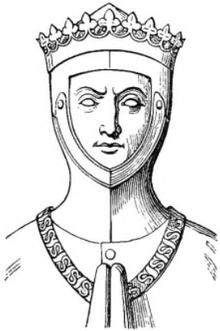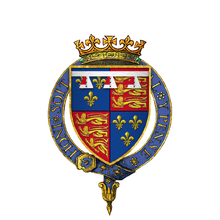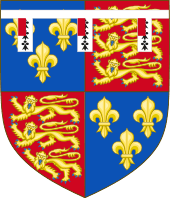Thomas of Lancaster, 1st Duke of Clarence
| Thomas of Lancaster | |
|---|---|
| Duke of Clarence | |
 Drawing of his tomb effigy | |
| Born |
Autumn 1387 [1] Probably London |
| Died |
22 March 1421 (aged 33) Battle of Baugé, Anjou, France |
| Burial | Canterbury Cathedral, Kent |
| Spouse | Margaret Holland (m. 1411) |
| Issue | John of Clarence (illegitimate) |
| House | Lancaster |
| Father | Henry IV of England |
| Mother | Mary de Bohun |
Thomas of Lancaster, 1st Duke of Clarence KG (autumn 1387 – 22 March 1421) was a medieval English prince and soldier, the second son of King Henry IV of England and brother of Henry V. He acted as councillor and aide to both. After the death of his father he participated in the military campaigns of his brother in France during the Hundred Years' War.
Heir to the throne in the event of his brother's death, he was left in charge of English forces in France when Henry returned temporarily to England after his marriage to Catherine of Valois. He led the English in their disastrous defeat at the hands of a mainly Scottish force coming to the aid of the French, at the Battle of Baugé. In a rash attack he and his leading knights were surrounded and Thomas was killed.
Early life

He was born before 25 November 1387 as on that date his father's accounts note a payment made to a woman described as his nurse.[2] 29 September 1388[3] sometimes features as his birth date, but it now seems clear that Thomas was born before Christmas 1387.[4] He was probably born in London,[2] but some sources give Kenilworth Castle.[5]
Thomas married Margaret Holland, widow of John Beaufort, 1st Earl of Somerset, and daughter of Thomas Holland, 2nd Earl of Kent, in November or December 1411. No children were born from this union, though Thomas was stepfather to her six children from her first marriage, who were his first cousins. He had, however, a natural son, Sir John Clarence, called "Bastard of Clarence" who fought by his father's side in France.
After his father became ill in 1411, his older brother became head of the royal council. Conflicts arose between the young Henry and his father when the prince gathered a group of supporters favouring his policy of declaring war on France. The prince was removed from the council by his father after he had defied the king's wishes by persuading it to declare war. Thomas was given his brother's seat, and fell in line with his father's peace policy.[6]
Military career

During the wars of his elder brother Henry V in France, Clarence fought in the Siege of Rouen (29 July 1418 – 19 January 1419), where he commanded the besieging force. After Henry had negotiated the Treaty of Troyes, in which he became heir to the French throne, the king returned to England with his new wife Catherine. The Dauphin, the disinherited former heir, refused to accept the situation and organised continuing resistance, aided by a Scottish army led by John Stewart, Earl of Buchan.
Following the King's instructions, Clarence led 4,000 men in raids through the Anjou and Maine.[7] This chevauchée met with little resistance, and by Good Friday, 21 March 1421, the English army had made camp near the little town of Vieil-Baugé. The Franco-Scots army of about 5,000 also arrived in the Vieil-Baugé area to block the English army's progress; it was commanded by the Earl of Buchan and the new Constable of France, the Sieur de Lafayette; however, the English forces were dispersed, and, significantly, many of the English archers had ridden off in search of plunder or forage. On Easter Saturday, one of these foraging groups captured a Scots man-at-arms whom they brought before the Duke of Clarence. Clarence was keen to engage the enemy; however, he had a problem: the following day was Easter Sunday, one of the most holy days in the Christian calendar, when a battle would be unthinkable. A two-day delay was also deemed as out of the question.[8][9] According to the chronicles of Walter Bower both commanders agreed a brief truce to celebrate Easter, but then joined battle that day.[10]
Perhaps underestimating the size of the Franco-Scottish army, Clarence decided to launch a surprise cavalry-led attack rather than use his archers against the enemy. With only about 1,500 men-at-arms available, and virtually no archers, he charged the Franco-Scottish lines. The shock temporarily disordered the Franco-Scots, but soon Clarence and his knights were overwhelmed. Clarence was unhorsed by a Scottish knight, Sir John Carmichael, and finished off on the ground by Sir Alexander Buchanan, probably with a mace.[8][11]
Aftermath
His natural son John accompanied the remains of his father from Baugé to Canterbury for their interment. This Sir John Clarence had a grant of lands in Ireland from Henry V and was buried in Canterbury Cathedral. The noble de Langlée family of France claimed him for their ultimate ancestor. Henry V was forced to return to France with a new army to retrieve the situation.
His executors, as seen in a legal record of 1430, were John Colvylle, of Neuton, Cambs, knight; Henry Merston, of Westminster, clerk & his widow, Margaret, Duchess of Clarence, living in Bermondsey, Surrey. [12]
Titles, styles, honours and arms
Titles and styles
| English Royalty |
| House of Lancaster |
|---|
 |
| Henry IV |
- Duke of Clarence (9 July 1412 – 22 March 1421); extinct upon his death until the Third Creation of it in (1461)
- Earl of Aumale (9 July 1412 – 22 March 1421); extinct upon his death
Honours
- Knight, Order of the Bath (12 October 1399 – 22 March 1421)
- Knight, Order of the Garter (1400 – 22 March 1421)
Offices held
- Lord High Steward of England (1399–1421) — he was the last permanent holder of this office, the highest in medieval England.
- Chief Governor of Ireland (1401–1413)
- Lord High Admiral (1405–1406)
- Lieutenant of Aquitaine (1412–1413)
- Lord High Steward of Chester (1415)
- Constable of the Army (1417)
- Lieutenant-General of the Army in France and Normandy (1417 and 1421)
Arms
Sources conflict as to Thomas' arms — as a son of the sovereign, Thomas bore the arms of the kingdom, differenced by either:
- a label of three points ermine.[13]
- a label of three points ermine, each cantoned gules, as depicted in the above image.
Ancestry
Notes
- ↑ Mortimer 2007, p. 372.
- 1 2 Mortimer 2007, p. 372.
- ↑ Kenneth J. Panton. Historical Dictionary of the British Monarchy. Scarecrow Press (2011). P. 473.
- ↑ Mortimer 2007, p. 371.
- ↑ Alison Weir (2008). Britain's Royal Families: The Complete Genealogy. Vintage. p. 125.
- ↑ J. Madison Davis, The Shakespeare Name and Place Dictionary, Routledge, 2012, p.399.
- ↑ Wagner, J. (2006). Encyclopedia of the Hundred Years War (PDF). Westport: Greenwood Press. ISBN 978-0-313-32736-0. Archived from the original (PDF) on 16 July 2018. pp. 43–44.
- 1 2 Brown. The Black Douglases: War and Lordship in Late Medieval Scotland, 1300-1455. pp. 216–218
- ↑ Neillands. The Hundred Years War. p. 233,
- ↑ Macdougall. An Antidote to the English p. 65
- ↑ Allmand, C. (2010-09-23). "Henry V (1386–1422)". Oxford Dictionary of National Biography (online). Oxford University Press. doi:10.1093/ref:odnb/12952.
- ↑ Plea Rolls of the Court of Common Pleas; National Archives; CP 40 / 677; http://aalt.law.uh.edu/AALT1/H6/CP40no677/aCP40no677fronts/IMG_0116.htm; second entry, as defendants
- ↑ Marks of Cadency in the British Royal Family
References
- Weir, Alison (2002). Britain's Royal Family: A Complete Genealogy. The Bodley Head London, U.K. ISBN 0-7126-4286-2. pages 102 & 123
- Cokayne, G.; Gibbs, V.; Doubleday, H.A., eds. (1913). The Complete Peerage. 3 (2nd ed.). London: St. Catherine Press. pp. 258–9.
- Cokayne, G.E. (2000). The Complete Peerage of England, Scotland, Ireland, Great Britain and the United Kingdom, Extant, Extinct, or Dormant. Alan Sutton. Vol I pg 368
- Harriss, G.L. (2010). "Thomas, duke of Clarence (1387–1421)". Oxford Dictionary of National Biography (online). Oxford University Press. doi:10.1093/ref:odnb/27198. Missing or empty
|url=(help) - Mortimer, I. (2007). The Fears of Henry IV: The Life of England's Self-Made King. London: Jonathan Cape. ISBN 978-0-224-07300-4.
External links
- "Thomas Plantagenet, duke of Clarence". Encyclopædia Britannica. 1998-07-20.
- Lundy, Darryl (ed.). "Thomas of Lancaster, 1st Duke of Clarence". The Peerage.
Thomas of Lancaster, 1st Duke of Clarence Cadet branch of the House of Plantagenet Born: 1387 Died: 22 March 1421 | ||
| Political offices | ||
|---|---|---|
| Preceded by The Duke of Lancaster |
Lord High Steward 1399–1421 |
End of permanent office |